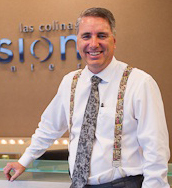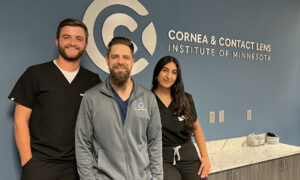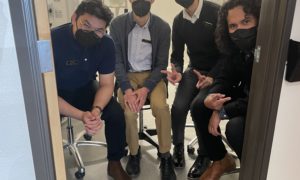By Ken Krivacic, OD, MBA
Staff retreats are vital for goal-setting—and can elevate the level of staff performance. Take the time, do it well, and you will see results.
Setting aside time to meet with your staff may not seem like a worthwhile endeavor to a harried doctor and his or her staff, but you would be wrong to jump to that conclusion. The time I have taken to meet with my team in a staff retreat has provided my practice with focused direction and ready-to-implement goals. Here are the keys to organizing a staff retreat including why it is a worthy investment of time and money.
Retreats Twice a Year
We currently employ 14 full-time staff, two part-time staff and two full-time doctors. I believe the larger the staff the more the office benefits from having a retreat. It is a great time to get in front of the entire staff and convey your vision of the practice to all employees. Even a staff of four to five would benefit from a staff retreat.
We have our retreats twice a year. The first is in the beginning of the year and emphasizes establishing goals and plans for the coming year. The second retreat is six months later and we use it to gauge if we are on track to meet our goals and if some goals need to be revised. The retreat is always performed off-site, usually at a local hotel or country club.
On retreat days, we work a short morning seeing patients and then go to the retreat location. We start in a relaxed manner by hosting lunch and then we delve into our program. The entire time for the retreat is approximately five hours. To keep employees interested and engaged, we break the afternoon into one-hour sessions with different topics in each session.
Why Bother with a Retreat?
Why hold a staff retreat? Aren’t you hurting your income by not seeing patients that day? How will you ever make up the lost revenue? Is it really worth the effort to take time from the schedule to just get away and plan? These are all valid questions. When we first started the process of taking time off to do a company retreat, I too was skeptical that it would benefit us. I realized the day of the retreat we would lose production and income, yet I believed that planning and organizing would reward us with future growth and a healthier culture at work. Benjamin Franklin said it well: “By failing to prepare, you are preparing to fail.”
Howard Dolman, OD, an optometrist in Ontario, Canada, who has been doing office retreats for just over ten years, initially started his retreats as half-day sessions. These half days evolved into full-day sessions three times a year. He is a big fan of the staffteam meeting. Dr. Dolman says: “I can’t say enough about how positive the all-day meeting sessions are for our office. They allow us to spend more time with the staff on specific policies and procedures to ensure that everyone is on the same page. It allows us to foster a more positive office culture through team building exercises. It gives us the opportunity to make sure that our staff are properly trained to understand the most important aspects of their job. It gives us the opportunity to make sure that the staff understand the business aspect of the practice and how we can work together to make the practice more successful.”
Cost Considerations: $40-$50 per Person
Between the room we rent and meals for the staff, we generally spend between $40-50 per person for the five hours we are away. There is also the cost of lost income for that day which obviously varies depending on the size of your practice.
I believe one of the biggest gains from conducting a staff retreat is that employees feel like they have a say in the direction of the practice. A more involved and engaged employee is a better employee. This translates into better performance and customer service that patients can sense. Again, I quote Benjamin Franklin: “Tell me and I forget, teach me and I may remember, involve me and I learn.” An educated and involved employee is one of the greatest assets to an optometric practice.
Planning: Set Aside At Least Four to Five Hours
The retreat is generally planned by me with a lot of help from our office manager. We usually sit down to discuss the topics we want to cover at the retreat starting approximately two weeks prior to the date. There may be several meetings leading up to the date. The entire planning process may take approximately four to five hours. I would recommend searching for a venue that is relatively close so as not to take too much time for the employees to get there. I would recommend beginning your search for the venue at least a few months in advance as some places may book up early for other meetings.
Create Flexible Agenda
Our agendas tend to follow a loose guideline. We always review our practice goal numbers. These include metrics such as production and collection numbers, number of exams performed, number of frames sold, retention rate (number of glasses sold per exams performed) and cost of goods. For those employees who are not numbers people this part of the retreat can become tedious. I’ve learned to limit that portion of the retreat to no more than an hour and to move through it rather quickly, highlighting the important points and not getting too involved in detail. Other topics can be more fun and stimulating such as a wish list in which no idea is a bad idea. Outrageous ideas may actually lead to more down to earth ideas that can be implemented. Below is a list of topics that could be used to conduct a staff retreat:
o Office metrics
o Wish list
o Marketing
o Team building activities
o Personality profile testing
o Vendor presentations
o HIPAA compliance updates
o Customer service presentations (live, webinar, YouTube)
Plan for Presentations
We don’t usually assign all employees a presentation for each retreat. We usually assign one of our lead people (office manager, optical manager, etc.) a topic to review. That may range from a new frame line we carry in the optical to a presentation on personality profiles and how that affects interactions between employees and patients.
Inspire Employees to Higher Performance
We try to inspire employees to higher performance through our sessions on customer service. These can be live through a guest speaker or by watching a webinar or YouTube clip. We have used YouTube several times with great success as it is usually followed by conversations about the clip and how that relates to what we do daily. I would recommend searching YouTube for clips sponsored by TED conferences. They are not specific to optometry, but many have great lessons for customer service in any business. After watching the video, take that lesson from another business and have the staff discuss how that applies to your day-to-day activities in optometry.
Avoid Monotony
We attempt to engage employees during the retreat by conducting a few team building exercises. This helps break up the monotony of just being talked to for the entire session. I suggest employees perform an exercise that involves people getting up and moving. This will not only stimulate the mind but also the body. A good source for team building exercises is the book “Quick Team-Building Activities for Busy Managers” by Brian Cole Miller.
Assign Employees to Work on Goals from Retreat
Once we have set goals, we assign a person to be the lead to see that the goal or project is implemented and completed. We also assign a completion date.
We e-mail a copy of our newly created wish list after every retreat to each employee. This list is then also reviewed monthly at one of our weekly staff meetings to see if we have met our goals. We review the progress of each project and revise projections if needed.
Staff Retreat: Action Plan
Schedule It. If you have never conducted a staff retreat in the past, schedule one now. If it’s not scheduled, it probably won’t get done. Allow yourself a few months to locate a venue and plan.
Get Away. Conduct the retreat offsite. This gives more meaning to the event, breaks away from the day-to-day routine and reduces the chance of interruptions.
Be considerate of others’ commitments and expect them to be the same of yours. Always explain that a meeting should finish on time because everyone has other commitments and time is precious. Using an agenda is a vital part of ensuring the meeting runs as scheduled and allotting time spaces for each item of business is crucial; again, the chair must be considerate of the time allotted and stick to it as best as possible.
Use humor. This makes meetings more interesting and helps to defuse possible negative conflicts. Make sure to let positive and constructive conflicts run their course. A good chair can use humor to aid this process.
Use Brainstorming Techniques. Don’t let your meeting get shut down by people shooting down each other’s ideas. If you think your ideas will be disregarded, you’ll be less likely to offer them up in the first place. Put every idea on the table without judging or criticizing, and then discuss which ones are the best. Everyone has to feel comfortable participating.
Related ROB Articles
Off-Site Retreats: Tune-Up Your Practice Performance
Staff Retreats: Teambuilding and Talent Enhancement Tool
Staff Retreat: Team Building and Goal Setting
Ken Krivacic, OD, is the owner of Las Colinas Vision Center in Irving, Texas. To contact him: kkrivacic@aol.com.



























